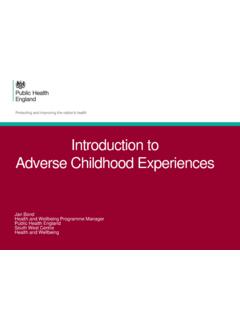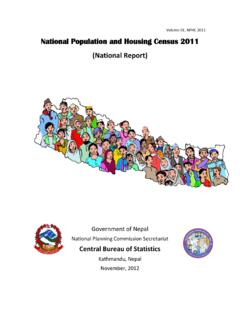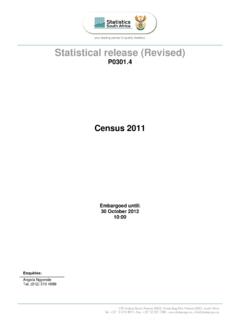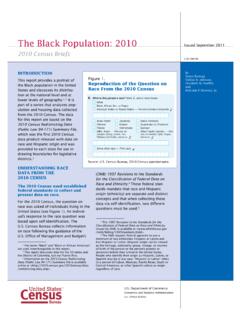Transcription of Ethnicity in Tower Hamlets
1 Ethnicity in Tower Hamlets Analysis of 2011 census data Summary of findings This briefing presents key statistics from the 2011 census about the ethnic composition of the Tower Hamlets population. The new census figures provide valuable intelligence about the nature of diversity in the borough and how it is changing. Key findings include: More than two thirds (69 per cent) of theborough s population belong to minorityethnic groups (ie not White British): 55 percent belong to BME (Black and MinorityEthnic) groups and a further 14 per cent arefrom White minority groups. The census provides data about 18different ethnic group populations. Theborough s three largest groups are theBangladeshi, White British and Other White populations. Considered together, people from these three ethnic groups make up around three-quarters of the Tower Hamlets population. The Bangladeshi population makes upalmost one third (32 per cent) of theborough s population considerably largerthan the proportion across London (3 percent) or England (under 1 per cent).
2 TowerHamlets has the largest Bangladeshipopulation in England. White British residents comprise 31 percent of the borough s population, far lowerthan the percentage nationally (80 per cent). Tower Hamlets has the fifth lowestproportion of White British residents inEngland. Newham and Brent had the lowestrates (17 and 18 per cent respectively). The third largest ethnic group in the boroughis the Other White group who compriseone in eight borough residents close to theLondon average. This group is very diverseand includes residents from a mix of ethnicbackgrounds (eg Europeans, Australians,Americans). Residents from Black ethnic groups makeup 7 per cent of the population comprising: 4per cent from Black African groups; 2 percent from Black Caribbean groups; and 1 percent from Other Black groups. TowerHamlets has a smaller proportion of Blackresidents compared to the London average(7 vs. 13 per cent).Research Briefing 2013-01 February 2013 Contents Page 1 About this briefing.
3 3 2 Background about the census .. 3 3 The ethnic group classification .. 4 4 Population by ethnic group in Tower Hamlets - overview .. 5 5 Ethnic profile: Tower Hamlets compared with other 7 6 census data on Somali residents in Tower Hamlets .. 9 7 Ethnic composition of the borough - Change over time .. 10 8 Multi-ethnic households .. 12 9 Measuring ethnic diversity .. 13 10 More information .. 14 Appendix A: Changes to the ethnic classification .. 15 Ethnicity in Tower Hamlets Summary Page 2 Somali was not included as a separateethnic group in the census , so it remainsdifficult to obtain a firm estimate of thenumber of residents who are ethnically Somali. However, census data on country ofbirth provide intelligence on first generationSomali residents these show that Somali-born residents comprise per cent of thepopulation up from per cent in 2001. Chinese residents comprise per cent ofthe borough s population this is the thirdhighest percentage in England, afterCambridge and the City of London (both cent).
4 Tower Hamlets has a smaller proportion ofIndian (3 per cent) and Pakistani (1 percent) residents compared with London (7and 3 per cent respectively). Residents from Mixed ethnic groupsrepresent 4 per cent of the borough spopulation, close to the London average (5per cent) and higher than the nationalaverage (2 per cent). The 2011 census is the first census toinclude Arab as an ethnic group. Arabresidents represented 1 per cent of theborough s population the same as theLondon average. Trend data show that the borough spopulation has grown by 30 per cent since2001 - the largest rise in England. Thepopulation has also become moreethnically diverse over the last ten years consistent with national and regionaltrends. The percentage of the borough s populationwho are White British has fallen from 43 to31 per cent, while most minority ethnicgroups have shown strong growth over theperiod. There were similar trends acrossLondon and England which both saw a fall inthe proportion of White British residents.
5 In contrast, the borough s Other White population has shown significant growthover the period and has more than doubledin size between 2001 and 2011 . Residentsfrom the Other White group now make up 12per cent of the borough s population upfrom 7 per cent in 2001. The picture wassimilar across London where the proportionincreased from 8 to 13 per cent between2001- 2011 . A number of other ethnic groups in theborough, though smaller in population size,have also seen quite fast growth (relative tothe overall growth rate for the borough of 30per cent). The following groups have morethan doubled in size: Mixed ethnic groups(+113 per cent); Indian (+126 per cent);Chinese (+127 per cent); Other Asian (+227per cent) and Black Other (+312 per cent). The Bangladeshi population has grown by 24per cent since 2001 (an increase in numberof 15,824 residents). However, because thepopulation grew at a slower rate than thepopulation generally (30 per cent), theproportion of the Tower Hamlets populationwho are Bangladeshi has fallen marginallyfrom 33 per cent to 32 per cent.
6 According to the Simpson s DiversityIndex, which takes account of the mix andsize of the 18 different ethnic groups in thepopulation, Tower Hamlets is the 16th mostdiverse local authority in England out of 326local authority areas (ie in the most diverse 5per cent of local authorities nationally). Within the London context, Tower Hamletsemerges as the 15th most diverse borough inLondon (out of 33 areas) with a diversityscore just above the London average. This briefing has analysed the first set of2011 census results about Ethnicity . Moredetailed figures about the characteristics ofthe borough s ethnic group populations areexpected in the coming in Tower Hamlets Analysis Page 3 1 About this briefing This briefing presents 2011 census data about Ethnicity and explores what the new data reveal about the Tower Hamlets population. The census provides a wealth of data about the characteristics of the local population and the results are being released in stages during 2012-2013.
7 The data in this briefing are based mainly on the second release of census data which took place in December 2012. At this time, the Corporate Research Unit produced an initial summary report of these results for Tower To follow this report, a series of topic reports is planned to provide more in-depth analysis of the data. This briefing on Ethnicity is the first of these reports and covers the following areas: An introduction to the new ethnic classification used in the census ; A profile of the ethnic composition of the borough s population; The ethnic profile in Tower Hamlets compared to that of other areas; Analysis of changes in the borough s ethnic group populations since 2001; Analysis of the Simpson s diversity index which quantifies how ethnicallydiverse Tower Hamlets is compared with other Background about the census The census aims to provide a count of all people and households in the UK and is carried out every ten years by the Office for National Statistics.
8 The 2011 census took place in March 2011 and the questionnaire collected data on a range of topics including: demography, diversity, labour market circumstances, housing and health. While the census aims for complete coverage, in practice it achieved a response rate of 94 per cent across England and Wales and about 91 per cent per cent in Tower Hamlets2. To deal with non-response ONS imputes the missing values so the final data accurately reflect the size and composition of the population. Response rates in Tower Hamlets have improved dramatically since the previous census in 2001 (up 15 percentage points from 76 per cent)3, improving the reliability of the data. One of the main strengths of the census is that, unlike sample surveys, it can provide reliable estimates for small groups within the population and for small areas within local authorities. This makes it particularly valuable for analysis of topics like diversity. Furthermore, as it takes place at the same time, in the same way, across the entire country, it enables comprehensive benchmarking of key data.
9 1 LBTH, Research Briefing 2012-12, 2011 census : Second Release - Headline Analysis 2 ONS, Response rates in the 2011 census 3 Greater London Authority, 2011 census quality assurance: London borough s response rates Ethnicity in Tower Hamlets Analysis Page 4 3 The ethnic group classification Ethnic classifications are the subject of considerable debate and many different classifications exist. Most classifications tend to reflect a mix of quite different aspects of cultural identity including: skin colour, geography, ancestry and national identity. The ethnic classification used by the Office for National Statistics (ONS) for 2011 census purposes took years to develop, and has been subject to various consultations and extensive testing4. The census ethnic classification tends to be one of most widely used for statistical and monitoring purposes. ONS has asked an ethnic group question on the census since 1991, and the classification has changed with each census .
10 ONS takes on board a wide range of factors in determining the final classification, including how the population changes over time, and the changing needs of data users and interest groups all of which have to be balanced against what is feasible. Of all the census questions, the development of the ethnic group question is thought to be one of the most complex. The 1991 census classification comprised 9 categories and, in 2001, this grew to 16 categories. At the same time, to help respondents navigate the longer list of groups, five summary headings were also added to the question. In the 2011 census , the classification expanded further to 18 categories with the inclusion of two new categories: Arab and Gypsy or Irish Traveller . In addition, there were also changes to wording and the placement of some groups. Appendix A explores the impact of these changes on comparability between 2001 and 2011 . Figure 1 shows the final classification used in 2011 . 4 Office for National Statistics, Final recommended questions for the 2011 census in England and Wales: Ethnic group, October 2009.















